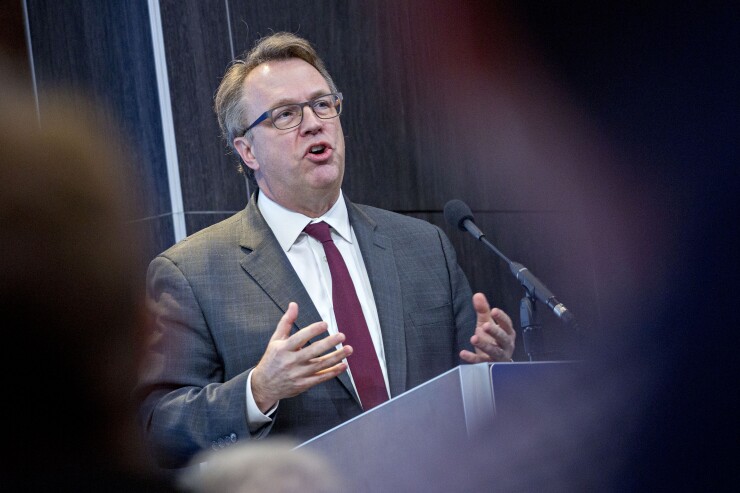The U.S. and the rest of the industrial world may have to resign themselves to an extended period of slow economic growth, subdued inflation and low interest rates. The trick will be in avoiding something even worse.
That’s the sobering message from the American Economic Association’s annual conference that brought economists and policy makers from around the world to San Diego for a three-day meeting that ended on Sunday.
Despite the U.S. and other major developed economies having recovered from the financial crisis of a decade ago and seen their unemployment rates come down a lot, “we’re still seeing no significant increases in estimates of productivity growth, in estimates of trend GDP growth or in R star,” the long-run equilibrium rate of interest that neither spurs nor hinders economic activity, said New York Federal Reserve Bank President John Williams.
“We have come to the realization that these factors are basically the hand we’ve been dealt for the next five to ten years,” he added.

If that’s indeed the case, policy makers confront a risky world. With growth and inflation so low, it wouldn’t take much to push industrial countries into the sort of deflationary malaise that afflicted Japan after its gigantic asset bubbles burst in the early 1990s. “Japan’s experience can happen in other countries,” said Bank of Japan Deputy Governor Masazumi Wakatabe.
Navigating the shoals ahead is going to be tricky and will require a rethink of the traditional playbook that countries have followed in fighting off recessions. With interest rates so low, central banks can no longer be counted on to combat contractions on their own. Fiscal policy makers will have to play a much larger fire-fighting part than they have traditionally through tax cuts and government spending increases.
While “monetary policy has a meaningful role play, it’s unlikely to be sufficient in the years ahead,” former Fed Chair Janet Yellen said. It “should not be the only game in town.”
Yellen, now at the Brookings Institution in Washington, said she agreed with former Treasury Secretary Lawrence Summers that the U.S. was enmeshed in secular stagnation — a state where desired savings are bigger than investment and interest rates are depressed as a result.
She ticked off a number of structural forces holding down interest rates — including an aging population and sluggish productivity — and suggested they might be around for a while. “These factors are apt to prove chronic by nature,” she said.
The U.S. nevertheless is better positioned than other major economies to handle the difficulties ahead. While U.S. growth, inflation and interest rates are all lower than they have been historically, they’re higher than in Europe or Japan.
Despite slowing productivity gains, the U.S. “has essentially been a great winner from the last era,” said former International Monetary Fund chief economist Kenneth Rogoff.
The dangers are greater in the euro area, where the European Central Bank has been forced to restart quantitative easing to lift sagging inflation expectations and a slowing economy.
“I believe that for the euro area there is some risk of Japanification, but it is by no means a foregone conclusion” if it acts comprehensively to avoid a deflationary future, former ECB President Mario Draghi said via a video link to the conference. “The euro area still has space to do this, but time is not infinite,” he added.
Draghi took euro area governments to task for working at cross purposes with the ECB’s efforts to aid the economy in recent years by pursuing restrictive fiscal policies. “This is why the ECB has been consistently calling for fiscal policy to play a stronger role and capitalize” on the low rates, he said.
He counseled policy makers in Europe against becoming resigned to slipping into deflation. “It is certainly not too late for the euro area to avoid this,” he said, adding, “The euro area is not in a deflationary trap.”
While Japan’s post-bubble experience is a cautionary tale for policy makers elsewhere, its most recent performance suggests not all is lost. Through a combination of super-easy monetary and fiscal policies, Japan has managed to lift itself out of deflation, though its inflation rate is still well short of the BOJ’s 2% target.
“Japan has succeeded partly in escaping Japanification,” Wakatabe said.
Peterson Institute for International Economics President Adam Posen said one lesson from Japan is the importance of fiscal and monetary policy coordination. “The Bank of Japan has basically gotten it right” by anchoring long-term interest rates that the government pays on its debt through a strategy of yield curve control, he said.
Summers played down fears that the huge government debt Japan has run up while breaking free of deflation will blow up the economy at some point in the future.
“My instincts are very much on the serenity side,” the Harvard University professor said, noting that global investors consider the yen to be a safe currency.
In the U.S., the low level of interest rates — and the likelihood they’ll persist — has sparked fears that will spawn such financial stability risks as asset price bubbles and excessive leverage. That “is a serious concern,” said Yellen, who also bemoaned the paucity of macro-prudential tools the U.S. has to deal with such a danger.
If Japan is any indication though, that may not be such a big worry. Despite years of super low interest rates, “we don’t see any sign of overheating asset prices,” Wakatabe said.
The same can be said for Europe, said ECB chief economist Philip Lane.
That though may be cold comfort to policy makers. Lane said the biggest ingredient for asset bubbles is excessive optimism.
That’s something that’s in short supply at the moment, at least among economists and policy makers, if this year’s AEA meeting is anything to go by.





